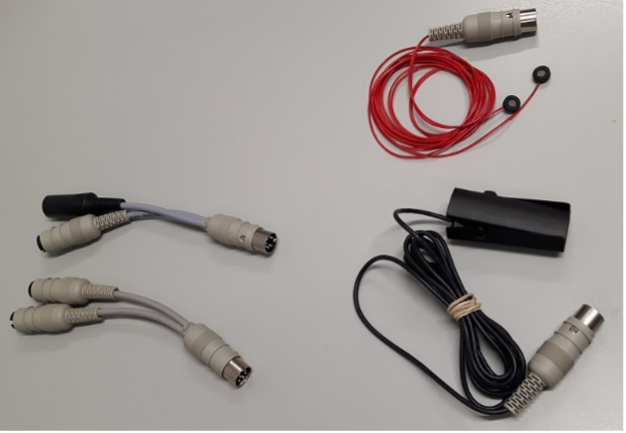
|
We have two sets of EEG equipment. The type is BioSemi ActiveTwo; it has 64 active electrodes om the scalp (plus 8 more electrodes elsewhere on the head, plus 8 additional channels), whose analog signals are digitized into 24 bits at a sample rate of 8 kHz. The equipment therefore spits out 80×3×8k = 1.92 MB of data per second, or over 1 GB every nine minutes.

In the picture you see the EEG acquisition device (or “AD-box”) sitting on top of the battery (yes, this is battery-powered, not mains-powered). In the set-up you see here, 32 electrodes are connecting the EEG device to a cap (we have different sizes of caps; e.g. we used rather small ones when testing two-months-old babies). This equipment is easy to handle and can be considered “mobile” (one of the sets has been to Prague).
Using EEG equipment is expensive. While the acquisition device itself doesn’t really degrade (our oldest is from 2009 and still works well), the same cannot be said of the electrodes, which have to be considered “consumables”: a set of electrodes has to be replaced after 100 to 150 participants, and it costs almost 4000 euros. If you have a large grant (NWO Vidi/Vici, ERC, NWO Open Competition) and want to do EEG, you are expected to sustain the lab by buying one or more sets of electrodes. As in such a case there are very likely other serious costs as well (e.g. paying toward the services of the technician, lab managers and research assistants), it is mandatory that you consult with the lab director (Paul Boersma) before drawing up the budget for the grant proposal, i.e. before calculating how many scientific personnel you can hire and for how long. We cannot stress this enough, because almost every year somebody comes to us with a large project in which they reserved too little funds for lab services and facilities, and you don’t want to be in such a situation.
If you don’t have such a large grant, i.e. you have “just” an NWO Veni grant, or a PhD grant (such as NWO PGw, or an ACLC or FGw grant), or if you are a BA or MA student writing a thesis or internship or tutorial, you will probably still be able to use the EEG equipment for your research, because the lab has (limited) funds for buying some electrodes every year. Please do consult in time with the technician (Dirk Vet) about whether this is possible for you. See financing for details.Apart from the 64 usual electrodes, you can also use sensors for galvanic skin response and blood flow (plethysmograph), also from BioSemi:

The location of the electrodes can be measured with the EMSE Locator software:

This makes use of the Polhemus Fastrak motion tracker:
